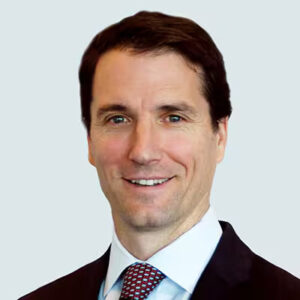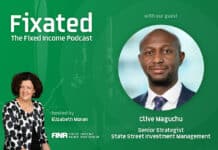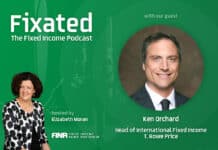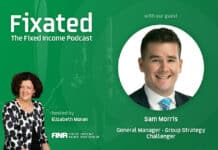
We sat down with Matthew Nest, Global Head of Active Fixed Income, State Street Global Advisers, the 4th largest asset manager worldwide, to discuss opportunities, risks and modernisation of the fixed income asset class.
Elizabeth Moran (EM): Perhaps if you could talk a little bit about where State Street sees opportunities in the fixed income market at the moment?

Matthew Nest (MN): Sure. So, I’ll point to a few areas we like and a few areas that we’re avoiding. We tend to like duration primarily in the US, the UK, and Australia. We like intermediate exposure, call it five-year government paper. We like agency mortgage-back securities in the US. We like structured credit more broadly. Emerging markets have become more interesting over the last 12 months or so. So, they’re the kind of areas we’re focused on investing in. I think the areas we like less are the long-ended yield curves for obvious reasons. Despite reasonably healthy fundamentals, corporate credit isn’t particularly attractive, largely from an evaluation perspective from where I sit.
EM – I can understand that. In terms of the structured credit that you like or you find attractive, in Australia, the yields between comparably rated corporate bonds and structured credit are different. Are they different in the US as well?
MN – Yeah, they’re different. I mean, obviously, we’re underwriting different risk. The underlying collateral is different. We’re generally looking at commercial and residential real estate, equipment finance, things of that nature. And you tend to see spreads anywhere from 150 basis points out to 300, if you move down the capital structure in those deals. Always in the investment grade space. And we don’t participate in the high yield portion of that market and the equity portion of that market. The investments compare relatively favourably to investment-grade corporate, with spreads of less than 100 basis points on average now. You’re also dealing with fairly short-dated instruments, which we tend to favour in this environment. So, for both the underlying collateral itself, and then the duration profile or the cash flow profile of the instrument, makes them feel relatively attractive to us compared to corporate credit.
EM – Great, can we talk a little about risks? Would you like to comment on how tariffs have impacted the market?
MN – Well, they certainly induced a lot of volatility in the markets over the past few months, that’s for sure. I think they’ve also increased the level of uncertainty associated with various markets. The interesting thing to me is how this has been reflected. If you look at where we are today, versus where we were at the start of the year, most of the risk premium that stuck has been in the rates market, not the credit markets. Obviously, there was volatility in credit spreads, but they’ve recovered quite strongly since. The rate markets also experienced that volatility and risk premiums increased, but those risk premiums have stuck.
So, that’s an interesting dynamic to me as we observe valuations in the markets, and one of the reasons why, despite all the risks associated in some of our debt markets now, that we like duration in our portfolios, because of those high risk premiums.
EM – What other risks are you considering besides tariffs at the moment?
MN– There’s all kinds of risks. Geopolitical risks, obviously, being one of them and reordering of the global system more broadly. I think valuation risk, at some level, particularly in corporate credit. There’s been this nascent forward-looking data versus spot data that has pointed to recessionary risks on the horizon for the last couple of years. That has yet to materialise. However, it still remains present in most of the forward-looking data. So, that’s also another risk we have to be cognizant of, yet and there’s no immediate signs of recession around the corner, the warning signs remain elevated.
Also read: Disaster Averted, But Bonds Still Behaving Badly
EM – It’s interesting, because I think investors in the equity market are looking a little complacent about that risk. But do you think fixed income investors are a little complacent towards recession risk as well?
MN– Well, certainly, the corporate credit markets, if you look at spreads, are in tune with the equity markets in that regard. I think the simple fact is I talk to my corporate credit analysts regularly and they keep telling me, “Yeah, now we get it. Now credit spreads are tight, but balance sheets are extremely strong. Earnings are strong. Growth in the economy is strong, but what are you worried about?” Which I understand. My rebuttal to them is always, “but look at all this forward-looking data that still points to recessionary risks on the horizon.” And so, you have this tug of war between what are fundamentally strong corporations for the most part and why you tend to see tight credit spreads, and high equity valuations, and strong earnings. But people are still somewhat worried at the macro level about the forward-looking indicators and the potential for a downturn in the economy.
EM – It’s interesting. I love to hear that there’s a bit of banter going on between the analysts about should we or shouldn’t we invest. But how do you incorporate those risks now in your asset allocation?
MN – I think there is also a bit of tug of war with respect to the asset allocation. And we have a team-based approach. And we’re focused on all the various points of input, in terms of how we make decisions around capital allocation and what it ultimately leads to. Because you have these two diverging opinions, kind of this macro opinion of, listen, there’s a lot of warning flags out here. But then the underlying kind of bottoms up where it’s saying there’s not a ton of risk you need to worry about. What you end up with is kind of like modest positions in risk-taking in corporate credit as a result, because there’s not consensus from the two views and the team with respect to that particular risk.
The second big part that comes into our process is the relative valuation. So, when we look at relative value across markets, there’s also like, okay, even if you believe there’s no underlying fundamental risk, that maybe you prefer the structural credit risk relative to corporate credit risk because of the valuation associated with that market.
EM – No, I understand. Just in terms of sovereigns. We’ve seen the US 10-year governments blow out and sitting over 5%. And we’ve seen investors shy away from the US globally, I think to a degree. Do you have any concerns about longer-dated US government bonds?
MN – I certainly have concerns. The last several months have taught everyone that correlations aren’t everywhere and always static. And you’ve seen the dollar decline at the same time rates have sold off, at the same time equity risk premiums and credit risk premiums widen. Some of that has reversed. But nonetheless, it is a good reminder for asset allocators that all the relationships that you relied on in the past may not exist going forward, so you need to think through at a very minimum scenario analysis around that potential. That’s one key consideration. The other is obviously there’s debt problems in the US, but there’s debt problems in most of the world. And money and capital ultimately have to flow somewhere.
And given the breadth and depth of capital markets in the US, and the rule of law, for the immediate future, when push comes to shove, capital will likely continue to flow into the US, when there’s problems. I think, though, over the longer term there are some serious concerns. And that’s why we don’t like the long end of the treasury curves or most government curves. Own the deterioration, the balance sheets, and the debt problems, the deficit problems, and ultimately how this ends up playing out. Do I think many of these governments ever default? No. But could the path towards those potential problems include similar scenarios that the UK experienced a couple of years ago with respect to their debt markets? Yes, absolutely. That’s a very significant risk and we’re keeping a close eye on.
EM – So, in terms of duration then, I take it you’re not taking long US government positions anyway or limited, longer-dated US government positions. How are you building in duration then into your portfolio?
MN – Mostly, we’re overweight the five and 10-year segments of the yield curve in our portfolios. Anchored mostly on the five-year. We’re comfortable with the profile at those maturities. And you also have to think of an environment where yields are relatively elevated. Growth sequentially is declining in most economies. And inflation, despite all the talk of tariffs, continues to decline in most economies in the world as well, leaving the cyclical dynamics with respect to interest rate exposure in that segment of the yield curve favorable in our view point.
EM – Australian investors have been drawn to private credit recently. And it’s much more of a growth market here than it is in the US. Do you have any views on private credit? And are you investing in private credit in any of your portfolios?
MN – So, we do invest in private credit in some of our portfolios in a small subset. I would say it’s important that investors understand private credit’s a pretty broad swath of instruments. You have direct middle market lending, you have asset-based finance, you have investment grade capital solutions, you have commercial and residential real estate risks. And so, it’s hard to paint a broad brush or make broad-brush statements around private credit. You really have to focus on the underlying collateral, the risk associated with it. And then, ultimately, the deal structures themselves and how they’re put together.
EM – Is there anything you’d like to impart to asset managers or managers thinking about investing in fixed income for the interview that we haven’t talked about?
MN – Yes, a few things. Obviously, the market structure has changed a ton over the past 10 or 15 years. We’ve gone from a place where most investors were investing in one aggregate bond portfolio, whether it be in this region, global aggregate or in the US, US and aggregate-type bonds. There’s been a lot of changes with respect to pulling apart the pieces and the growth of ETFs, the growth in trading operations, the evolution of the regulation of banks and therefore the increase in private lenders. All of that on the good side allows investors a lot more choice, but a lot more points of access to these various markets. A lot more ways to put these different pieces together. And then a lot more ways to extract value out of the markets relative to where you were 10 or 20 years ago.
All that’s fantastic, but at the same time creates many more choices. It’s like if you’re at the restaurant and you have three options, it’s somewhat easy. If you have 100, it becomes challenging sometimes. So, it creates an environment where investors have to pay a lot more attention to how these things are put together, what they’re being offered, all the choice that they have, and be thoughtful about who and what partners they engage with on that front.
EM – Great comment. So, you were talking about the modernisation of the asset class. Of course, there’s faster trading now. How’s that influencing markets? Do you see that changing markets as well?
MN – Yes, it changes markets a ton. What it allows us to do as a provider is, one, push the envelope with respect to indexing. The amount of the market that you could index today vastly exceeds what you could index 10 years ago. Think of high yield bank loans, CLOs, emerging markets, all of these complex areas of the market that were very difficult to index effectively 10 years ago, now investors and ourselves can index very effectively and investors can access those markets much more efficiently. So, that’s one. I mean, the second is that it allows new approaches to active fixed income. We’ve been focusing a lot of our time and energy on systematic approaches to investing in the fixed income markets. Again, 10 years ago, not really feasible. Today, it’s much more possible given the evolution of the markets.
And then lastly, the way that investors are able to achieve objectives has become much more sophisticated. Whether you’re thinking about cash flow matching or liability investing, or target maturity investing for retail clients, or income investing, the ability to package fixed income in a way to meet those objectives more effectively is significantly more advanced than it was 10 years ago, as well.

































